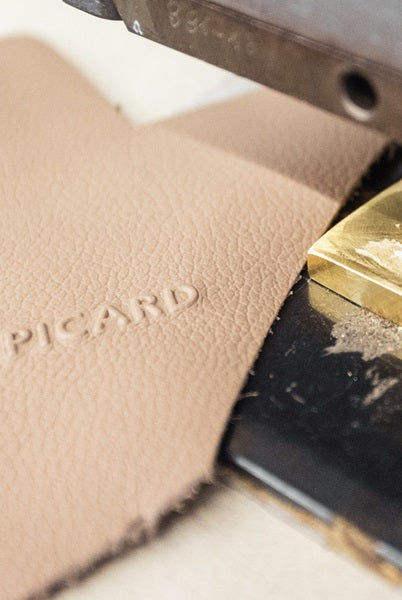
Certificates and symbols
AZO-free, LWG, genuine leather, REACH, GRS - clear so far? The leather industry is teeming with certificates and corresponding abbreviations. We are also sufficiently certified and use certain symbols to indicate certain standards. Not always easy to get through. Here we explain to you what it is all about, so that you can better find your way around our collections.
WHAT ARE AZO DYES?
Azo dyes are synthetically developed dyes. They are characterized They are characterized by a particularly strong coloration and exceptional lightfastness. With over 2000 organic compounds, azo dyes are the largest group of dyes. In the past, azo dyes were extracted from coal tar, but today they are obtained from petroleum by means of a chemical reaction. Azo dyes may release aromatic amines, which are toxic. Aromatic amines are classified as carcinogenic or toxic because they can be dissolved by saliva or sweat and enter the body. Pseudoallergic reactions are also possible. Nowadays, only dyes classified as harmless are permitted.
WHAT IS THE HEALTH RISK?
Azo dyes, which contain aromatic amines, are banned in textiles and leather in Germany under the German Commodities Ordinance (BedGgstV). Across Europe, azo dyes are also banned in consumer products under the REACH Regulation. This ban applies to all textiles and leather that can come into direct and prolonged contact with human skin or the oral cavity (in the case of food). Currently, 24 aromatic amines are affected, of which benzidine is the best known. In the EU, these dyes have not been used in the textile and leather industries for years. Since even imports of consumer goods (such as textiles from Asia) may not be dyed with such health-endangering dyes, random tests are carried out by the responsible authorities.
(Here in the text at REACH regulation, perhaps link to the landing page of the same name).
WHAT ALTERNATIVE DYES ARE THERE?
Natural dyes
Natural dyes are again more in demand than in the past, but they are more costly to produce. The range of colors is smaller than for the synthetic variants. Well-known substances in this category are indigo, madder red, redwood, yellowwood, bluewood or fisewood. For example, chamois leather is dyed black by reacting bluewood and yellowwood dyes with ferrous sulfate. Bluewood contains the brown-red substance hematin, which is released under steam pressure and uniformly dyes chrome leather.
Synthetic dyes
In the era of color chemistry, the natural dyes used until then were replaced by synthetic dyes (aniline dyes). In 1878, the structure of indigo was elucidated by Adolf von Bayer. He was awarded the Nobel Prize for Chemistry for this discovery. In 1897, the chemical company BASF successfully started large-scale production of synthetic indigo. Subsequently, a large number of dyes in various colors and types were developed.
Various artificially produced dyes fall into this group:
- Acid dyes (these dyes are salts of color sulfonic acids).
- Substantive dyes (dye chrome leather directly, i.e. without addition of acids)
- Basic dyes (are salts of organic dye bases)
- Sulfur dyes (water-insoluble sulfur-containing dyes)
- developing dyes (azo dyes and their metal complexes)
THE "GENUINE LEATHER" SYMBOL
Leather refers to hides and skins whose fiber structure has not been altered. Leather that has been dissolved or ground, glued and processed into webs is not "leather". An applied layer of dye or foil must not be thicker than 0.15 mm. Otherwise, the term "artificial leather" should be used here.
As a symbol for leather products, the stylized representation of a spread animal skin has become common. It is often found in brochures, on product labels or on websites. Furthermore, manufacturers of leather clothing and leather shoes in particular like to use the symbol with the supplementary designation "Genuine Leather" to inform the consumer that the product meets the requirements for the genuine leather designation and does not consist of imitation leather.
Special features of coated leather: Coated leather is leather where an application of dye or foil is thicker than 0.15 mm and does not exceed 1/3 of the total thickness. If the application is thicker than 1/3, then it is no longer "leather", but an artificial leather.
The leather symbol is not a protected symbol, however most leather symbols are similar. As a dealer of leather goods, care must be taken not to simply copy and adopt the symbol from a competitor, but to create your own. Otherwise, there may be accusations of plagiarism and warnings. In addition, there are also fraudsters who use this symbol even though it is not genuine leather. The German Leather Industry Association warns fraudsters in such cases.
What does REACH mean?
REACH stands for "Registration, Evaluation, Authorisation and Restriction of Chemicals".
(Registration, Evaluation, Authorization and Restriction of Chemicals).
REACH came into force on June 1, 2007, and is a European Union regulation enacted to protect human health. Likewise, it protects the environment from risks that can be posed by chemicals. It also proposes alternative methods for assessing the hazards of substances in order to reduce the number of animal tests.
In principle, REACH applies to all chemical substances. This applies to substances used in industrial processes, as well as those found in everyday life. For example, in cleaning agents, paints/lacquers as well as in products such as clothing, furniture and electrical appliances. Therefore, the regulation has an impact on most companies throughout the EU.
Under REACH, companies bear the burden of proof. To comply with the regulation, companies must identify and manage the risks associated with the substances they manufacture and place on the market in the EU. They must demonstrate to ECHA (the EU's European Chemicals Agency) how the substance can be used safely, and they must provide users with information on risk management measures.
If the risks cannot be managed, authorities can restrict the use of substances in various ways. In the long term, the most hazardous substances should be replaced by less hazardous ones.
How does REACH work?
REACH establishes procedures for the collection and evaluation of information on the properties and hazards of substances.
Any producer or importer of an article, distributor or other actor in the supply chain who places an article on the market must comply with the information requirements of Article 33 of REACH.
Companies must register their substances; to do so, they must cooperate with other companies that register the same substance.
ECHA (the EU's European Chemicals Agency) receives individual registrations and evaluates them for compliance, while EU member states evaluate selected substances to address initial concerns for human health or the environment. ECHA's authorities and scientific committees evaluate whether the risks of substances can be managed.
Authorities can ban hazardous substances if their risks cannot be managed. They can also decide to restrict a use or make it subject to prior authorization.
WHAT ARE POLYURETHANES?
Polyurethanes are plastics or synthetic resins. It is hard to imagine our modern everyday life without them. The flexible material has many advantages: It is extremely light and yet very hard-wearing. Plastics can be processed extremely well and have considerable insulating properties. Polyurethanes can be used, for example, to better insulate houses, build lighter vehicles or more powerful wind turbines.
However, the material is difficult to recycle. Waste products and offcuts made from plastic during product manufacture largely end up in landfills and incinerators. This is not only a problem in view of growing mountains of plastic waste and advancing global warming. Valuable substances are also lost as a result, because plastic consists in part of non-renewable raw materials, including petroleum. Currently known procedures for recovering the basic materials are very costly.
HOW CAN RESOURCES BE CONSERVED?
The plan to conserve resources has both economically and ecologically worthwhile goals. If more products are made from recycled plastic in the future, less plastic will go to waste incineration for energy recovery and there will be fewer CO 2 emissions. In addition, less plastic waste would end up in landfills worldwide. Currently, plastics are recycled mainly by means of mechanical processes, also known as mechanical recycling. For this purpose, plastic waste is sorted by type of plastic, washed, melted down and processed into so-called recyclates. These recyclates serve as starting materials for new products and thus replace plastics made from virgin material. The chemical structure of the plastics is retained during mechanical recycling.
POLYURETHANES & SUSTAINABILITY
Polyurethanes help to save energy in a sustainable way. With their help, architects can better insulate buildings. Less gas, oil and electricity will then be consumed there. Otherwise, more heating or cooling would be needed. Thanks to polyurethanes, car manufacturers can make their vehicles more attractive and build lighter bodies so that the vehicles consume less fuel and have lower emissions. Refrigerators insulated with polyurethane foams make food last longer and avoid wastage. Accessories such as bags, purses or belts can also be made from recycled polyurethanes.
What is the Global Recycled Standard (GRS)?
The Global Recycled Standard (GRS) is managed by the non-profit organization Textile Exchange. WHAT IS GRS?
GRS stands for Global Recycled Standard, a standard that verifies the presence and amount of recycled material in fabrics and tracks the flow of raw materials from source to final product. It is an international, voluntary, full product standard that sets requirements for recycled content certification, chain of custody, social and environmental practices, and third-party chemical restrictions.
WHAT IS THE GOAL OF THE GRS?
The goal of the GRS is to increase the amount of recycled materials in a product. The standard allows companies to record the exact percentage of recycled material in a product and track it through the production chain. The GRS also includes requirements on the additives used in GRS products, as well as guidelines on environmental management and corporate social responsibility. Traceability of recycled materials as well as transparency in the production chain is done with the help of the overarching Content Claim Standard (CCS). Companies working with this standard must ensure that at least 20 percent of the product is made from recycled materials. The GRS logo, on the other hand, can only be used on a final product if at least 50 percent of the product is made from recycled materials.
What does LWG stand for?
LWG stands for "Leather Working Group." The Leather Working Group is a non-profit organization responsible for the world's leading environmental certification of the leather industry. You can find more information in our article about it.
What does LEFA mean?
LEFA stands for leather fiber and is an environmentally sound leather alternative. Find out more about it in our article about LEFA.
Symbols in our online shop
To better identify our products, we use symbols on our product detail pages to indicate certain certifications of a product. Since some products have many certifications, we have limited the number of icons displayed to a maximum of 3 per product.






